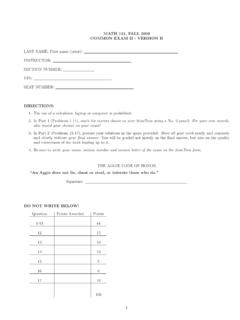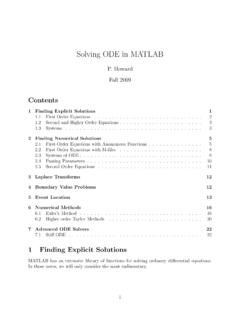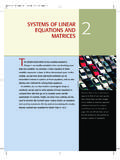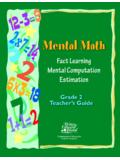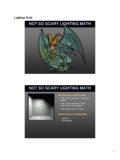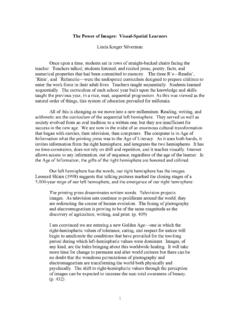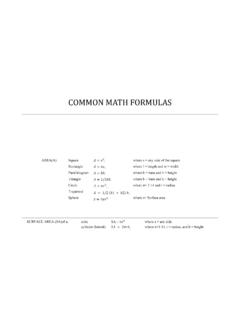Transcription of Thales of Miletus1 - Texas A&M University
1 Thales of Miletus11 Thales Life and AccomplishmentsLittleisknownofThales. Bornabout624 BCinMiletus,AsiaMinor(now Turkey), he was the son of Examyes and Cleobuline. He diedabout 546 BC in Miletos, bust shown above is in the Capitoline Museum in Rome, but is notcontemporary with Thales . Indeed, though there are statues and otherimages of significant people of the time, there is little assurance of impression and highlights of his life and work follow:1c 2000, G. Donald AllenThales2 Thales of miletus was the first known Greek philosopher, scientistand mathematician. Some consider him the teacher of Pythagoras,though it may be only be that he advised Pythagoras to travel toEgypt and Chaldea.
2 From Eudemus of Rhodes (fl ca. 320 ) we know that hestudied in Egypt and brought these teachings to Greece. He isunanimously ascribed to have introduced the mathematical andastronomical sciences into Greece. He is unanimously regarded as having been unusally clever bygeneral agreement the first of the Seven Wise Men2, a pupil ofthe Egyptians and the Chaldeans. None of his writing survives and no contemporary sources exist;thus, his achievements are difficult to assess, particularly his phi-losophy and mathematical discoveries. Indeed, many mathematicaldiscoveries of this early period have been attributed to others, oftencenturies later. In addition one must consider the ancient practiceof crediting particular discoveries to men with a reputation forwisdom.
3 This is no doubt certainly true in Pythagoras case. There is, of course, the story, related by Aristotle, of his successfulspeculation in olive oil presses after he had concluded there wouldbe a bountiful harvest as testament to his practical businessacumen. The Greek writer Xenophanes claimed that he predicted an eclipseof the Sun on May 28, 585 BC, startling all of Ionia and therebystopping the battle between the Lydian Alyattes and the MedianCyaxares. Modern scholars, in further analysis, believe this storyis apocryphal, that he could not have had the knowledge to predictan eclipse so accurately. Herodotus spoke of his foretelling theyear only. However, the fact that the eclipse was nearly total andoccurred during this significant battle possibly contributed to hisreputation as an astronomer.
4 It is very likely he used Babyolonianastronomy in his prediction. He is also said to have used his knowledge of geometry to measurethe Egyptian pyramids, though it is equally likely he brought thisknowledge back from his studies in Egypt. The reputed method2 Besides Thales , the other of the Seven Wise Men were Bias of Priene, Chilon of Sparta,Cleobulus of Lindus, Pittacus of Mytilene, Solon of Athens and Periander of CorinthThales3was to use their shadows and therefore proportionality of the sidesof similar triangles. He is credited with five theorems of elementary geometry. Thiswill form the center of our study. Being asked what was very difficult, he answered, in a famousaphorism, To Know Thyself.
5 Asked what was very easy, he an-swered, To give advice. To the question, what/who is God?, heanswered, That which has no beginning or no end. (The infi-nite!?!) Asked how men might live most virtuously, he answered, If we never do ourselves what we blame in others. According to Diogenes Laertius, Thales died while present as aspectator at a gymnastic contest, being worn out with heat andthirst and weakness, for he was very old. From W. K. C. Guthrie3we haveThe achievement of Thales , has been represented by histo-rians in two entirely different lights: on the one hand, asa marvelous anticipation of modern scientific thinking, andon the other as nothing but a transparent rationalization of to Guthrie himself, one may say that ideas of Thalesand other Milesians created a bridge between the two worlds the worldof myth and the world of the mind.
6 Thales believed that the Earth is a flat disk that floats on an endlessexpanse of water and all things come to be from water. This comes tous from Aristotle who suggested that Thales was the first to suggest asingle material substratum for the universe. But, more preciesly, Thalesand the Milesians proceeded from the assumption of a fundamentalunity of all material things that is to be found behind their apparentdiversity. This is the first recorded monism, or monistic cosmology, inhistory. He also regards the world as alive and thus life and matter to beinseparable. Even plants he feels have a immortal soul . (This form ofpantheism, present in the early stages of Greek philosophy, held that the3W.)
7 K. C. Guthrie, A History of Greek Philosophy, vol. 1 (Cambridge: Cambridge Uni-versity Press, 1962), p. is one of the elements in the world whose function is to animatethe other elements that constitute the world is calledhylozoism.)Perhaps the essense of this contribution is that it marks an awaken-ing in mankind the desire to investigate the universe on a non-religiousbasis, to model the universe and to derive conclusions from the would be many models considered, studies, and rejected beforeour contemporary one. So the new task of philosophers was to estab-lish what exactly provided this unity: one said it was water; another,the Boundless; yet another, air. (The goal is, of course, the quest forrational understanding of the world.
8 Answering The Big Questions is the most difficult.)) Thales is believed to have been the teacher of Anaximander; he isthe first natural philosopher in the Ionian (Milesian) School. AccordingAnaximander of miletus (mid-6th century), the wordapeironmeant un-bounded, infinite, indefinite, or undefined. Originally used to referencetheunlimitedand that which preceded theseparationinto contrastingqualities, such as hot and cold, wet and dry, it thus represented theprimitive unity of all phenomena. Thus, for the Greeks, the originalchaos out of which the world was formed wasapeiron. Evidence existsthat he wrote treatises on geography, astronomy, and cosmology thatsurvived for several centuries.
9 He is also said to have made a mapof the known world. A rationalist, he prized symmetry and introducedgeometry and mathematical proportions into his efforts to map the heav-ens, a tradition that has continued throughout history. We may concludethat his theories departed from earlier, mystical models of the universeand anticipated the achievements of later on a linear path from Thales , Anaximander s successor,Anaximenes of miletus (second half of the 6th century), taught that airwas the origin of all things. Anaximenes, supplementing the theoriesof Thales and Anaximander specified the way in which the other thingsarose out of the water or apeiron. He claimed that the other types ofmatter arose out of air by condensation and rarefaction.
10 In this way, wesee another building block in the development complete model, that ofthe explanation of phenomena, and this remained essentially the samethrough all of its Thales MathematicsThales is also said to have discovered a method of measuring the dis-tance to a ship at sea. There are several theories that conjecture hisexplanation. The first is to use sightings on short and to construct acongruent triangle on shore and measure the unknown distance. Thisexplanation would have little utility, because the time of measurementof a distant ship would be so long as not to be of similarity, a bit of geometry known at the time and in partic-ular to Thales if the pyramid story is anywhre near accurate, an alternateexplanation uses two shore observation points, where the angles to theship are measured.

